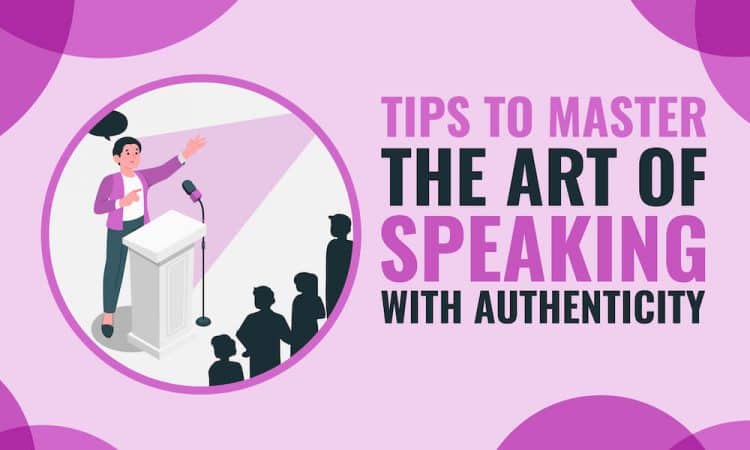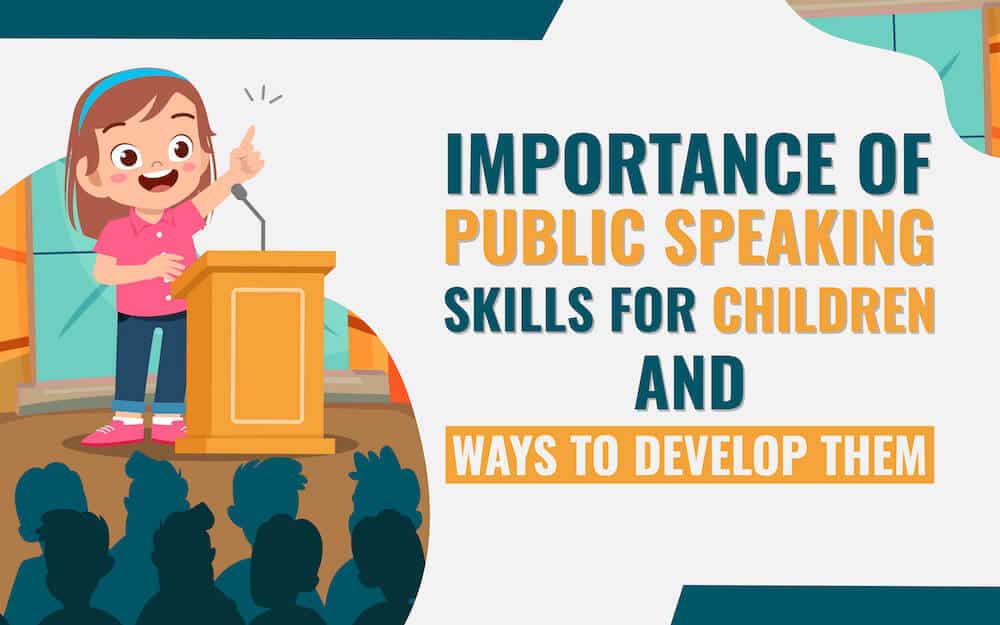
Suppose you are attending an event. The event has an impressive and compelling lineup of speakers. The speakers come on the stage one by one, deliver their speeches, and leave. You find that all speakers were masters in their subject matter.
However, there was only one presenter whose presentation resonated with you deeply and lingered in your mind. You naturally get drawn to his story of vulnerability and resilience.
Do you know what made you more inclined toward that speaker? Well, it was his authenticity that he gracefully infused with his knowledge, words, and body language.
Authenticity is the soul of public speaking. It adds credibility to your presentation and turns it into a meaningful conversation. By being authentic, you can make the audience remember not just the message but also the person behind that message – that’s you.
Let’s explore why authenticity is important for public speakers, how it can be inculcated in your speech, and how you can find your authentic style.
Why Authenticity Matters for Public Speakers?
1. Fosters Meaningful Connections
Nobody is perfect. So, it’s natural that when someone pretends to be perfect, we automatically feel distanced.
Being authentic and true to yourself can help you form connections that are deep, meaningful, and based on trust and understanding.
When you come from a space of openness and honesty, it usually strikes the same chord with other people, transcending physical and emotional barriers.
2. Boosts Confidence
Being authentic helps you recognize your real strengths and weaknesses. More often than not, people are crippled with an inflated sense of themselves, and that’s what they try to convey to other people. The result is an unconvinced audience and a not-so-impactful delivery.
When you are comfortable in your skin, it exhibits another level of confidence, which will automatically help you tackle stage nervousness and fear.
Being authentic will help you in a big way in building connections and pave the way for more career-building and networking opportunities.
3. Builds Trust with the Audience
You need trust to build any relationship, and that’s all the more imperative in a professional setup. A successful business arrangement is made possible with mutual respect and trust.
Authenticity isn’t just through words – it’s the energy you share with people. When they feel that, it becomes easier to take your message home. Remember, your audience won’t trust your words and speech if they sense you are unreal.
4. Inspires Others
If you are someone who embraces their uniqueness, you will give everyone else the same space. A culture like that can only inspire a positive cycle engulfing people around you.
When you lead by example – it will be easier for others to follow suit. So, be as open, truthful, and honest in your speech as possible to let everyone embrace your unique self. Not only will it help them relate to you more, but they will also get inspiration to follow.
5. Adapts to Diverse Audiences
Authenticity is adaptable, and it goes beyond demographic and cultural differences. People are amazingly perceptible and can pinpoint when something is off, even without overtly realizing it.
You can count on relating to diverse audiences much more (barring the differentiating factors of your audience) as authenticity as a trait belongs to us as a species, and we understand it like that.
Tips to Become an Authentic Speaker
1. Understand Your Audience and Connect with Them
It is very common for speakers to want to look good and competent on stage. The focus is on delivering in such a way that it hits the right chords in all aspects.
Most speakers assume that long preparation hours spent polishing the oration and visual aspects of the presenter would 100% translate into a successful delivery. But it’s not always the case.
Authentic speakers are not concerned about how people will perceive them. A real effort to understand the people and deliver what would actually help them takes off the pressure of pleasing people.
So, what you can do is-
- Use examples, anecdotes, or personal stories to build connections.
- Speak clearly, and avoid jargon.
- Use empathy to connect with people and tailor your speech according to what suits everyone.
- Understand your objectives clearly to bring that into your communication.
- Speak with emotions if need be.
2. Be You, Unapologetically
Imagine you are part of a TED talk. The presenter on the stage is a renowned man known for his fancy and lavish lifestyle. He gets on stage and starts talking about the importance of simple living for the sustainability of the planet. You might listen to him, but would you feel connected?
We are a product of our values and beliefs. People are going to take your words more seriously when they connect with you and your cause. Authentic speakers know how to be themselves and embrace their uniqueness to play it to their strength.
Align with your values and see if you can weave your speech around that. It will be easy connecting for people when they see how much you care about your cause.
3. Create a Welcoming Environment
How comfortably would you speak if you were talking to a loved one at home? Or when you host a party and want people to feel welcomed and taken care of?
Even your nonverbal cues are relaxed with a smiling face, at ease shoulders, open stance, natural body language, etc. That’s the emotional state you should seek to be in when you deliver your speech.
So, instead of jumping straight to the agenda, try to start with a warm welcome to set a positive and welcoming tone for your speech.
You can try things like –
- Smile at people and appreciate and thank them for their time.
- Take the help of icebreaker activities.
- Pose some fun or thought-provoking questions to break the monotony and encourage participation.
4. Know Your Objective/Intention
Your presentation should have a clear purpose, and that purpose should be clear to you as well. There is something you seek to achieve from your talk, something that you would want people to remember.
Remembering the “why” of your presentation will help you speak with purpose and connect and communicate with people effectively.
For instance, if your presentation is about the environment, your objective is to inform people about the dangers we face.
Similarly, you could be giving a presentation for a new job offer, and the objective could be to convey your reliability and strength as a person.
5. Align Your Gestures and Body Language with Your Intention
Body language and gestures have their own importance in public speaking. When there is a disconnect between what a speaker says (I am very excited about this new product) and how they say it (slouched shoulders, flat face, no eye contact) – the audience pays attention to more than what the words say.
Be yourself when you speak, and your gestures, postures, and facial expressions should support your words so as not to give different messages.
Use nonverbal cues to your advantage to enhance your delivery.
What you can do is-
- Smile periodically and remember to show other genuine emotions.
- Pauses will help you create suspense. It will also give people the space to reflect on what you said.
- Make natural, steady eye contact with people, covering all parts of the room.
- Don’t rely on filler words (so, umm, ah, and) to fill your speech. It will distract people and make you look unprofessional. Pausing will help you eliminate the use of it.
- Stand straight with your weight on both feet rather than slouching or leaning on one side.
- Your gestures should be natural and easy. Avoid crossed arms or other closed positions that can block you from people.
6. Choose a Topic You are Passionate About
When you are passionate about something, the energy reflects even through your body, face, and gestures (nonverbal means of communication). Finding and choosing a topic like that will do the majority of the work for you.
Ask yourself-
- What is in your topic that you deeply connect with?
- What is at stake?
- Why are you giving this presentation?
- What results do you seek in the end?
Don’t focus on what you want to say but why you are saying it. Infuse that emotion and passion in your speech to help people see through your eyes.
7. Infuse the Right Amount of Emotions in Your Speech
Emotions help humanize the message. We are often scared of infusing our speech with emotions in a professional setup. However, the need to appear competent and professional can sometimes result in a robotic and disengaging delivery.
That being said, the emotions must be genuine and not forceful (just for the sake of including).
Learn to tap into your feelings and channel the right amount into your speech to ace your communication skills. It will make you look authentic, approachable, and relatable.
8. Listen and Respond to the Audience
Your audience will be expecting something from your presentation. Be aware of how people respond to you during the presentation.
Tuning your mind to observe emotions and any nonverbal clues will help you improve (when needed) your delivery and connect to people more.
It will help you correct the course, slow down or pick up the pace, explain something better, ask an impromptu question, vary your tone and pitch, change parts of your talk, etc., making you look more authentic and accommodating.
9. Embrace Vulnerability
Being vulnerable in your speech would mean openly sharing your thoughts, feelings, emotions, and experiences with people.
You let go of the need to be perfect and polished and embrace your authenticity by expressing your true self. In doing so, you take your message to the next level by building a deep connection, trust, and credibility with people.
Embracing vulnerability would give everyone a chance to see the human behind the lectern and not just the expert relaying facts and information.
However, be mindful of things like –
- Don’t start with a narrative that contradicts and negates your credibility. For instance, “I didn’t have time to prepare,” “I was super nervous to be here,” etc.
- Your statements shouldn’t imply that you expect your audience to take care of you. When you stand at the podium, you are already in a position of authority. Remember to act like it while being vulnerable at the same time.
10. Be Prepared, Not Rehearsed
People sound rehearsed and canned because they try to memorize the speech verbatim. However, you can be fully prepared without having to go through the ordeal of learning by rote.
One way is to practice out loud without following the script. You will be different in each run-through, but it will also help you be more exact, spontaneous, and authentic each time (since there is nothing to follow).
So, prepare well, but don’t focus on excessive rehearsals focused on memorization. Remember, authenticity can’t be rehearsed and faked. It happens organically.
Finding Your Authentic Style
You can try to be funny, serious, chatty, to the point, and a lot of other things in your speech.
However, the catch is that if you can’t relate to yourself in those moments, people will feel it, too.
So, how do you figure out your authentic style? How do you reach the space when the person standing in front of the attendees is the real you with no manufactured personality traits?
Let’s go through the 3 ways to find your original style and nail your speech.
a). Let Not You Be the Focus
There is a lot of pressure and focus on you when you are standing on the other side of the podium. All eyes are on you, and people are ready to judge every small thing you do and say.
It becomes easy to fall into the urge of being more, which paves the way to being what you are not. Try to shift the focus from you to the audience. Try to get a sense of the room and who are the people you will be presenting to.
For instance, if you are a speaker in a long lineup, there are chances people are already tired and lethargic. They wouldn’t be able to relate to an over-enthusiastic you.
Similarly, try to shift the focus on the ‘what’ of your information and not ‘how’ you present it. Your information is important enough to be shared; that’s why it’s there in the first place. So, the content per se should be the point of interest more than how it’s delivered.
The technique will give you the space to try and find your authentic speaking style.
b). Enjoy Flexibility
Let’s imagine a scenario. You start with your presentation (as planned), but as you progress, you notice you have started losing people. There is a general disinterest.
Now, the 2 roads laid out for you are –
- Continue with the script and hope that everything will fall into place.
- Feel the pulse of your audience and improvise in that very moment.
How you choose to move ahead now will depend on how scripted or authentic you are.
Being flexible and spontaneous will allow you to assess the situation in real-time and make decisions that are best suitable, paving the way to finding your authentic speaking style.
c). Be Relaxed
Pre-speech jitters are normal, and even seasoned speakers experience their fair share of it. So many things can throw you off – an unanticipated question, a heckler, technical errors, time rush, glossophobia, etc.
All of this can really make you nervous and fearful of presenting. Stress reduces your ability to gauge situations and respond responsibly, and in a situation like that, you can never be authentic.
So, try to be relaxed and stress-free as much as possible. The audience will read your energy and be more confident in you. A relaxed state will empower you, restraining you from reacting mindlessly to situations encountered during the speech. You can count on being more authentic in your delivery when you are calm and composed.
The Bottom Line
Authenticity reflects the connection between your beliefs, words, and gestures. A slight disconnection between these three will give an impression that your speech is not genuine; it’s scripted. As a result, you can lose the interest of the audience in your talk.
Remember, there is no rule book for learning authenticity. You can achieve it only by being yourself. So, next time when you step on the stage to deliver your speech, be sure not to be just a subject expert but an authentic speaker as well.



